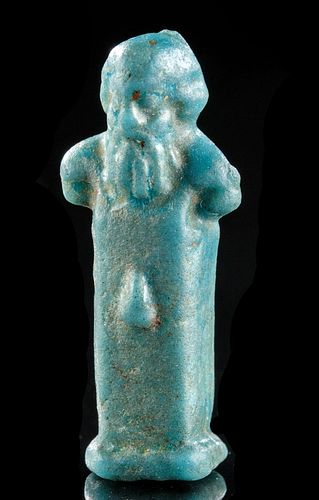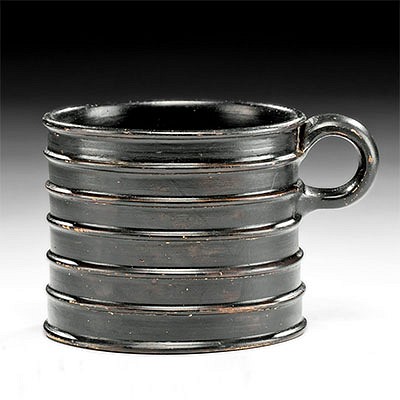Rare Egyptian Glazed Faience Herm Amulet, ex Sotheby's
Lot 5d
About Seller
Artemis Fine Arts
686 S Taylor Ave, Ste 106
Louisville, CO 80027
United States
Selling antiquities, ancient and ethnographic art online since 1993, Artemis Gallery specializes in Classical Antiquities (Egyptian, Greek, Roman, Near Eastern), Asian, Pre-Columbian, African / Tribal / Oceanographic art. Our extensive inventory includes pottery, stone, metal, wood, glass and textil...Read more
Categories
Estimate:
$1,600 - $2,250
Absentee vs Live bid
Two ways to bid:
- Leave a max absentee bid and the platform will bid on your behalf up to your maximum bid during the live auction.
- Bid live during the auction and your bids will be submitted real-time to the auctioneer.
Bid Increments
| Price | Bid Increment |
|---|---|
| $0 | $25 |
| $300 | $50 |
| $1,000 | $100 |
| $2,000 | $250 |
| $5,000 | $500 |
| $10,000 | $1,000 |
| $20,000 | $2,500 |
| $50,000 | $5,000 |
| $100,000 | $10,000 |
| $200,000 | $20,000 |
About Auction
By Artemis Fine Arts
Mar 12, 2020
Set Reminder
2020-03-12 10:00:00
2020-03-12 10:00:00
America/New_York
Bidsquare
Bidsquare : Ancient / Ethnographic Around The World
https://www.bidsquare.com/auctions/artemis-gallery/ancient-ethnographic-around-the-world-4957
Ancient art from Egypt, Greece, Italy and the Near East, as well as Asian, Fossils, Pre-Columbian, Native American, African / Tribal / Oceanic, Spanish Colonial, Russian Icons, Fine art, much more! Artemis Fine Arts info@artemisfinearts.com
Ancient art from Egypt, Greece, Italy and the Near East, as well as Asian, Fossils, Pre-Columbian, Native American, African / Tribal / Oceanic, Spanish Colonial, Russian Icons, Fine art, much more! Artemis Fine Arts info@artemisfinearts.com
- Lot Description
Egypt, Late Dynastic to Ptolemaic period, ca. 664 to 30 BCE. A mold-formed faience amulet depicting a columnar figure known as a herm worshipped by the Greeks to worship Hermes or other male deities. The petite, turquoise-glazed amulet bears a pillar-form body atop an integral rectangular plinth and has a masculine upper body with muscular shoulders, stocky biceps, and protruding genitalia. The elderly visage bears a bushy beard, almond-shaped eyes, cupped ears, and a wavy coiffure. Herm or herma are figural columnar pieces with a head, sometimes a torso, and male genitals carved at the appropriate height. They are thought to derive from the ancient Greek practice of worshipping divinities that were in the form of cairns or columns of stone or wood. Herms were apotropaic symbols and were kept in a variety of locations like crossroads, temples, public places, and in homes. Size: 0.55" W x 1.3" H (1.4 cm x 3.3 cm)
Provenance: ex-Phoenicia Holyland Antiquities, New York, New York, USA; ex-Sotheby's, New York "Antiquities" auction (December 7, 2001, part of lot 245); ex-private collection, acquired between 1955 and 1965
All items legal to buy/sell under U.S. Statute covering cultural patrimony Code 2600, CHAPTER 14, and are guaranteed to be as described or your money back.
A Certificate of Authenticity will accompany all winning bids.
We ship worldwide and handle all shipping in-house for your convenience.
#153623Minor nicks and abrasions, with light fading to original glaze, and softening to some finer details, otherwise intact and very good. Light earthen deposits and nice remains of original glaze throughout.Condition
- Shipping Info
-
All shipping is handled in-house for your convenience. Your invoice from Artemis Gallery will include shipping calculation instructions. If in doubt, please inquire BEFORE bidding for estimated shipping costs for individual items.
-
- Buyer's Premium



 EUR
EUR CAD
CAD AUD
AUD GBP
GBP MXN
MXN HKD
HKD CNY
CNY MYR
MYR SEK
SEK SGD
SGD CHF
CHF THB
THB













